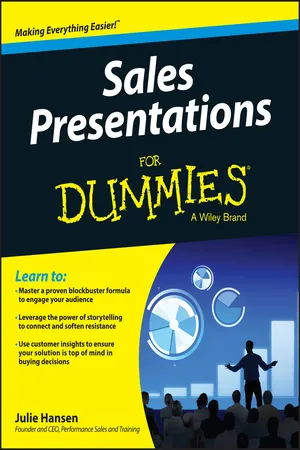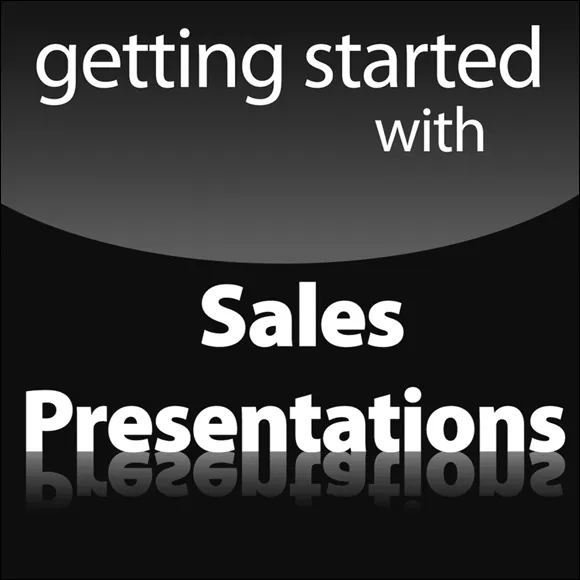
- English
- ePUB (mobile friendly)
- Available on iOS & Android
Sales Presentations For Dummies
About This Book
Are your sales presentations stuck in the 20 th century?
Sales Presentations For Dummies rises to the challenge of guiding you through the process of engaging and persuading busy buyers in a world that's constantly bombarding them with sales pitches. Motivating today's buyers to pull the trigger on a new deal requires a certain set of skills, and this straightforward text guides you through what you need to know to create and deliver compelling presentations. Pulled from examples and experiences of thousands of actual sales presentations, the information in this innovative resource offers the tools and tips you need to keep your leads engaged from hook to call to action.
Today's business landscape is competitive. When your sales presentation is being compared to countless others, it's important to stand out for all the right reasons. Instead of using dated sales approaches, update your understanding of the art of selling—and create compelling, engaging presentations that hook audience members from the beginning.
- Leverage a proven, blockbuster formula that engages audiences in any industry
- Use the power of storytelling to connect with prospective clients and soften their resistance to your sales pitch
- Understand and apply customer insights to ensure that your solution is top-of-mind in purchasing decisions
- Update your professional skill set to encompass today's most motivating sales tactics
Sales Presentations For Dummies brings your sales style into the 21 st century and connects you with the skills you need to excel in today's complicated business landscape.
Frequently asked questions
Getting Started with Sales Presentations








Embracing the Future of Sales Presentations





Understanding What an Effective Presentation Can Do
Tailoring to meet your prospect’s needs
- Why buy? Many prospects are hesitant or afraid to change. Selling against the status quo is a much different strategy than the next question.
- Why buy from you? Making a case for you over your competition in your presentation requires clear and concise differentiation — not always easy when differences are slight.
Gaining attention
- Attention spans fall: It’s not just your imagination. Studies show that people’s attention spans are falling faster than the Russian ruble — dropping an incredible 50 percent in the last decade — wait, is that a new LinkedIn request?
- Attention bottoms out. Attention isn’t something you get once in a presentation and then you’re done. Attention starts off high at the beginning of your presentation and drops to its lowest point in ten minutes, just when you were getting to your good stuff.
- Multitasking is a myth. Finally the truth is out. People can really only focus on one thing at a time. That has loads of implications for your presentation. For example, talking about one thing while an unrelated text-heavy slide is on the screen? Waste of your breath.
Planning a Killer Presentation
www.ted.com — have shed insight into what engages audiences today, you want your prospect to do more than feel good when you’re done. You need a persuasive structure that leads to action, which I discuss in the following sections.Hook them with the opening
- Capture attention. Use a relevant opening hook — something that makes your prospect put down his smartphone and pay attention, like a story, a quote, or an insight — to get off to a strong start.
- Define the situation. Quickly comparing how your prospect is dealing with the problem to what your prospect’s situation looks like after the problem is resolved gives your prospect a reminder of why you’re there and a vision of where you’re headed.
- Establish value. Busy prospects hate to have their time wasted. Giving them a sense of value initially is critical to gain early buy-in.
- Sell the next minute. Like many movie previews, too many salespeople reveal the whole plot in their opening. Keep interest and attention high by holding something back to keep your prospect tuned.
Create tension in the body
- Establish priority: Prospects often have competing p...
Table of contents
- Cover
- Title Page
- Table of Contents
- Introduction
- Part I: Getting Started with Sales Presentations
- Part II: Building a Blockbuster Presentation
- Part III: Delivering an Impactful Presentation
- Part IV: The New Rules of Engagement: Interacting with Your Audience
- Part V: Focusing on Special Types of Presentations
- Part VI: The Part of Tens
- About the Author
- Cheat Sheet
- Connect with Dummies
- End User License Agreement

